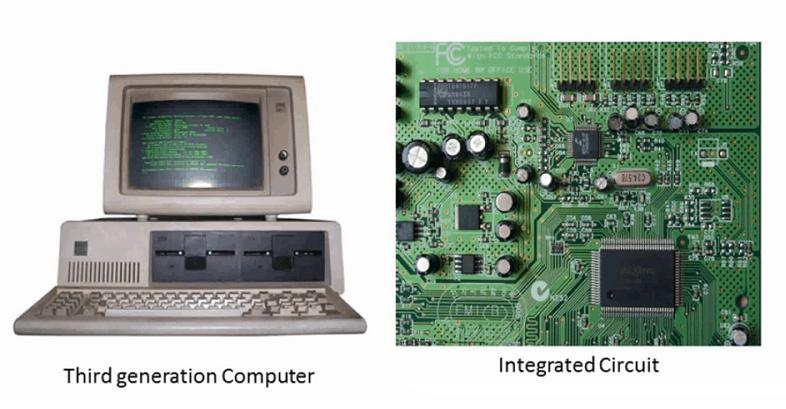Introduction
In1958,theengineerofTexasInstrumentsJackKilbyinventedtheintegratedcircuit(IC),combiningthreeelectroniccomponentsintoasmallsiliconchipsuperior.Morecomponentsareintegratedonasinglesemiconductorchip,andcomputersbecomesmaller,consumelesspower,andarefaster.Thedevelopmentofthisperiodalsoincludedtheuseofanoperatingsystem,whichallowedthecomputertorunmanydifferentprogramssimultaneouslyunderthecontrolandcoordinationofthecentralprogram.
Features
LSI(Large-ScaleIntegration)isusedtoformthemainfunctionalcomponentsofthecomputer,integratedcircuits(integratedhundredstothousandsoflogicgatesoneachchip)Itisalogiccircuitformedbyconcentratingmultipleelectroniccomponentsonasubstrateofafewsquaremillimeters.Thebasicelectroniccomponentsofthethird-generationcomputeraresmall-scaleintegratedcircuitswithseveraltoadozenelectroniccomponents(logicgates)integratedoneachsubstrateandmedium-scaleintegratedcircuitswithdozensofcomponentsoneachchip.
Thefurtherdevelopmentofcomputersoftwaretechnology,especiallythegradualmaturityoftheoperatingsystem,isasignificantfeatureofthethirdgenerationofcomputers.Thedevelopmentofmultiprocessors,virtualmemorysystems,anduser-orientedapplicationsoftwarehavegreatlyenrichedcomputersoftwareresources.Inordertomakefulluseoftheexistingsoftwareandsolvetheproblemofsoftwarecompatibility,aseriesofcomputershaveappeared.ThemostinfluentialistheIBM-360computerseriesdevelopedbyIBM.
Anotherfeatureofthisperiodistheapplicationofsmallcomputers.ThePDP-8,PDP-11seriesandlaterVAX-11seriesdevelopedbyDECCorporationhaveplayedagreatroleinthepromotionofcomputers.Itischaracterizedbytheuseoftransistorsinsteadofelectrontubes;alargenumberofmagneticcoresareusedasinternalmemory,andmagneticdisks,tapes,etc.areusedasexternalmemory;thesizeisreduced,thepowerconsumptionisreduced,thecalculationspeedisincreasedtohundredsofthousandsofbasiccalculationspersecond,andthememorycapacityisexpandedtoHundredsofthousandsofwords.
Whenthecomputerlanguagedevelopstothethirdgeneration,ithasenteredthe"human-oriented"languagestage.Thethird-generationlanguageisalsocalled"high-levellanguage".High-levellanguageisaprogramminglanguagethatisclosetopeople'shabits.ItallowstowritecalculationprogramsforsolvingproblemsinEnglish.Thearithmeticsymbolsandexpressionsusedintheprogramaresimilartothemathematicalformulasweusedaily.Thehigh-levellanguageiseasytolearnandhasstrongversatility.Thewrittenprogramisrelativelyshort,whichisconvenientforpromotionandcommunication.Itisanidealprogramminglanguage.High-levellanguagesdevelopedfromthemid-1950stothe1970s.Somepopularhigh-levellanguageshavebeenadoptedbymostcomputermanufacturersandaresolidifiedinthecomputer'smemory,suchastheBASIClanguage(nolessthan128differentBASIClanguageshavebeenpopular,ofcourseThebasiccharacteristicsarethesame).InadditiontotheBASIClanguage,therearemorethan250high-levellanguagessuchasFORTRAN(formulatranslation),COBOL(CommonBusinessLanguage),Clanguage,DL/Ilanguage,PASCAClanguage,andADAlanguage.
Computerhistory
Developmentstage | Logicelement | Mainmemory | Calculationspeed(persecond) | Software | Application |
Thefirstgeneration(1946-1958) | Electronictube td> | Electronicraytube | Thousandstotensofthousandsoftimes | Machinelanguage,assemblylanguage | Militaryresearch,scientificcomputing |
Secondgeneration(1958-1964) | Transistor | Core | Hundredsofthousandsoftimes | Monitoringprogram,high-levellanguage | Dataprocessing,transactionprocessing |
Thethirdgeneration(1964-1971) | Smallandmedium-sizedintegratedcircuits | Semiconductor | Hundredsofthousandstomillionsoftimes | Operatingsystem,editingsystem,applicationprogram | Ithasdevelopedalotandstartedtobewidelyused td> |
Thefourthgeneration(1971-present) | LargescaleScaleintegratedcircuit | Higherintegratedsemiconductors | tensofmillionstohundredsofmillionsoftimes | Perfectoperatingsystem,databasesystem,high-levellanguagedevelopment,applicationdevelopment | Infiltratealllevelsofsociety p> |
Thefirstgenerationofelectronictubecomputers(1945-1956):
OnFebruary15,1946,ENIAC(ElectronicNumericalIntegratorandComputer)wasmadepublicinPhiladelphia.ENIACrepresentsamilestoneinthehistoryofcomputerdevelopment.Italsohasparallelcomputingcapabilitiesthroughrewiringprogrammingbetweendifferentparts.ENIACisjointlydevelopedbytheUSgovernmentandtheUniversityofPennsylvania.Ituses18,000tubes,70,000resistors,5millionsolderjoints,consumes160kilowattsofpower,andhasacalculationspeedof5,000operationspersecond.Thefirstgenerationofcomputersischaracterizedbyoperatinginstructionsthatareprogrammedforspecifictasks.Eachmachinehasitsowndifferentmachinelanguage,itsfunctionsarelimited,anditsspeedisslow.Anotherobviousfeatureistheuseofvacuumtubesanddrumstostoredata.
Thesecond-generationtransistorcomputer(1956-1963):
Thesecond-generationtransistorcomputer(2photos)
In1948,thetransistorTheinventionreplacesthebulkyelectronictube,andthevolumeofelectronicequipmentcontinuestodecrease.In1956,transistorswereusedincomputers,andtransistorsandmagneticcorememoryledtothesecondgenerationofcomputers.Thesecond-generationcomputersaresmallinsize,fast,lowpowerconsumption,andmorestableinperformance.In1960,thereweresomesecond-generationcomputersthatweresuccessfullyusedinbusiness,universities,andgovernmentdepartments.Second-generationcomputersusedtransistorsinsteadoftubes,andsomepartsofmoderncomputers:printers,tapes,disks,memory,operatingsystems,etc.Theprogramsstoredinthecomputermakethecomputeradaptableandcanbeusedmoreeffectivelyforcommercialpurposes.Duringthisperiod,moreadvancedlanguagessuchasCOBOLandFORTRANappearedtomakecomputerprogrammingeasier.Newprofessions(programmers,analystsandcomputersystemsexperts)andtheentiresoftwareindustrywereborn.Thefourth-generationlarge-scaleintegratedcircuitcomputer(1971-):
Thefourth-generationlarge-scaleintegratedcircuitcomputer(3photos)
(LSI)canholdhundredsofcomponentsononechip.Bythe1980s,verylargescaleintegratedcircuits(VLSI)containedhundredsofthousandsofcomponentsonachip,andlater(ULSI)expandedthenumbertothemillions.Theabilitytoaccommodatesuchanumberofcomponentsonacoin-sizedchipmakesthesizeandpriceofthecomputercontinuetodecline,whilethefunctionalityandreliabilitycontinuetoincrease.Inthemid-1970s,computermanufacturersbegantobringcomputerstoordinaryconsumers.Atthistime,minicomputerswereequippedwithsoftwarepackageswithfriendlyinterfaces,programsfornon-professionals,andthemostpopularwordprocessingandspreadsheetprograms.In1981,IBMintroducedpersonalcomputers(PCs)foruseinhomes,offices,andschools.Thecompetitionofpersonalcomputersinthe1980scausedpricestocontinuetofall,thenumberofmicrocomputerscontinuedtoincrease,andcomputerscontinuedtoshrinkinsize.TheAppleMacintoshseries,whichcompeteswiththeIBMPC,waslaunchedin1984.TheMacintoshprovidesafriendlygraphicalinterfacethatuserscaneasilyoperatewithamouse.Application
1.Numericalcalculation:ballistictrajectory,weatherforecast,highenergyphysics,etc.
2,informationmanagement:enterprisemanagement,materialmanagement,computerization,etc.
p>3.Processcontrol:industrialautomationcontrol,satelliteflightdirectioncontrol
4.Auxiliaryengineering:computer-aideddesign(CAD),computer-aidedmanufacturing(CAM),computer-aidedinstruction(CAI),ComputerAidedTesting(CAT),ComputerAidedEducation(CAE),ComputerAidedPublishing(CAP),etc.

